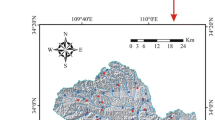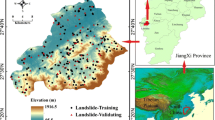Abstract
The mechanism of landslide occurrence is complicated due to the dependency and nonlinear relationship of various physical factors. A promising prediction model, which can be used to locate the high-risk regions and a corresponding prevention strategy can be prepared to reduce the slide occurrence and its consequence, is therefore desired. To perform the landslide assessment for a large-scale slope, this study proposes to use the method of small watershed that is integrated with Relevance Vector Machine (RVM) to enhance the prediction accuracy. Effect of physiographic and hydrological factors such as slope steepness, dip slope ratio, landslide ratio, and cumulative rainfall are investigated. To estimate the occurrence of landslide, RVM first maps the aforementioned factors into a feature space using Gaussian radial basis function. A linear boundary, distinguishing landslide or not, is then obtained through the search of the optimal weights. To find these weights, a Bayesian theory-based optimization problem is formulated and solved by iteratively reweighted least squares algorithm and the Laplace approximation procedure. The proposed model is validated by the data collected from Kaoping River Basin. Results indicate that the proposed RVM-based small watershed approach possesses a prediction accuracy of 87.5%, which is better than those of using Support Vector Machine (SVM), Least-Square Support Vector Machine (LS-SVM), and logistic regression, providing authorities in their hazard alert system to minimize the life or property losses caused by the landslide.







Similar content being viewed by others
References
Abbas H, Tezcan J (2019) Relevance vector machines modeling of nonstationary ground motion coherency. Soil Dyn Earthq Eng 120:262–272. https://doi.org/10.1016/j.soildyn.2019.02.002
Bishop CM, Tipping ME (2000) Variational relevance vector machines, proceedings of the. In: 16th conference on uncertainty in artificial intelligence, Morgan Kaufmann publishers Inc, San Francisco, CA, USA, pp 46–53
Chan HC, Chang CC, Chen SC, Wei YS, Wang ZB, Lee TS (2015) Investigation and analysis of the characteristics of shallow landslides in mountainous areas of Taiwan. J Chin Soil Water Conserv 46(1):19–28
Chang KT, Chiang SH, Hsu ML (2007) Modeling typhoon-and earthquake-induced landslides in a mountainous watershed using logistic regression. Geomorphology 89(3–4):335–347
Chang SC (1987) The prediction of potential geological hazards of Slopeland and its applications in environmental impact assessment. J Chin Soil Water Conserv 18(2):41–62
Cheng MY, Hoang ND (2015) Typhoon-induced slope collapse assessment using a novel bee colony optimized support vector classifier. Nat Hazards 78(3):1961–1978. https://doi.org/10.1007/s11069-015-1813-8
Cruden DM (1991) A simple definition of a landslide. Bulletin of Engineering Geology and the Environment 43(1):27–29
Dai F, Lee CF, Wang S, Feng Y (1999) Stress–strain behaviour of a loosely compacted volcanic-derived soil and its significance to rainfall-induced fill slope failures. Eng Geol 53(3–4):359–370
Dai FC, Lee CF (2002) Landslide characteristics and slope instability modeling using GIS. Lantau Island, Hong Kong, Geomorphology 42:213–228
Fan JC, Yang CH, Chang SC, Huang HY, Guo JJ (2013) Effects of climate change on the potential of the landslides in the basin of Kaoping stream. J Chin Soil Water Conserv 44(4):335–350
Fan, JC, Liu, CH, and Wu, MF (2003) Determination of Critical Rainfall Thresholds for Debris-Flow Occurrence in Central Taiwan and Their Revision after the 1999 Chi-Chi Great Earthquake, Proceedings of 3rd International Debris Flow Hazard Mitigation Conference, Davos, Switzerland, 10–12 : 103–114
Fan JC, Huang HY, Liu CH, Yang CH, Guo JJ, Chang CH, Chang YC (2015) Effects of landslide and other physiographic factors on the occurrence probability of debris flows in Central Taiwan. Environ Earth Sci 74:1785–1801
Fan JC, Chang SC, Liao KW, Guo JJ, Liu CH, Chang YC,... Yang CH (2018) The impact of physiographic factors upon the probability of slides occurrence: a case study from the Kaoping River Basin, Taiwan. Journal of the Chinese Institute of Engineers 41(5):419–429
Ge Y, Chen H, Zhao B, Tang H, Lin Z, Xie Z, Lv L, Zhong P (2018) A comparison of five methods in landslide susceptibility assessment: a case study from the 330-kV transmission line in Gansu region, China. Environ Earth Sci 77(19):662
Highland L, Bobrowsky PT (2008) The landslide handbook: a guide to understanding landslides (p. 129). Reston: US Geological Survey
Hoang ND, Bui DT (2016) A novel relevance vector machine classifier with cuckoo search optimization for spatial prediction of landslides. J Comput Civ Eng 30:04016001
Hung JJ, Lin ML, Chen TC, Wang KL (2000) 921 chi-chi earthquake disasters characteristics of slope failure case analysis: dip slope failure. Sino-Geotechnics 81:17–32
Jaafari A, Panahi M, Pham BT, Shahabi H, Bui DT, Rezaie F, Lee S (2019) Meta optimization of an adaptive neuro-fuzzy inference system with grey wolf optimizer and biogeography-based optimization algorithms for spatial prediction of landslide susceptibility. CATENA 175:430–445. https://doi.org/10.1016/j.catena.2018.12.033
Kavzoglu T, Colkesen I, Sahin EK (2019) Machine learning techniques in landslide susceptibility mapping: a survey and a case study. In: Pradhan SP, Vishal V, Singh TN (eds) Landslides: theory. Practice and Modelling. Springer International Publishing, Cham, pp 283–301. https://doi.org/10.1007/978-3-319-77377-3_13
Le HV, Bui QT, Tien Bui D, Tran HH, Hoang ND (2018) A hybrid intelligence system based on relevance vector machines and imperialist competitive optimization for Modelling Forest fire danger using GIS. J Environ Inf. https://doi.org/10.3808/jei.201800404
Liu Y, Ye Y, Wang Q, Liu X, Wang W (2019) Predicting the loose zone of roadway surrounding rock using wavelet relevance vector machine. Appl Sci 9(10):2064
Pham BT, Tien Bui D, Prakash I (2017) Landslide susceptibility assessment using bagging ensemble based alternating decision trees, logistic regression and J48 decision trees methods: a comparative study. Geotech Geol Eng 35(6):2597–2611. https://doi.org/10.1007/s10706-017-0264-2
Pradhan B, Lee S (2010) Landslide susceptibility assessment and factor effect analysis: Backpropagation artificial neural networks and their comparison with frequency ratio and bivariate logistic regression Modelling. Environ Model Softw 25(6):747–759
Samantaray AK, Singh G, Ramadas M (2019) Application of the Relevance Vector Machine to Drought Monitoring. In, Singapore, Soft computing for problem solving. Springer Singapore, pp 891–898
Suykens JA, De Brabanter J, Lukas L, Vandewalle J (2002) Weighted least squares support vector machines: robustness and sparse approximation. Neurocomputing 48(1-4):85–105
Tien Bui D, Pradhan B, Lofman O, Revhaug I (2012) Landslide susceptibility assessment in Vietnam using support vector machines, decision tree, and Naïve Bayes models. Math Probl Eng 2012:26. https://doi.org/10.1155/2012/974638
Tien Bui D, Shahabi H, Shirzadi A, Chapi K, Hoang ND, Pham B, Bui QT, Tran CT, Panahi M, Bin Ahamd B, Saro L (2018) A novel integrated approach of relevance vector machine optimized by imperialist competitive algorithm for spatial modeling of shallow landslides. Remote Sens 10(10):1538
Tipping ME (2000) The relevance vector machine. In Advances in neural information processing systems, MIT Press 12:652–658
Tipping ME (2001) Sparse bayesian learning and the relevance vector machine. Journal Machine Learn Research 1:211–244
Tipping ME (2004) Bayesian inference: an introduction to principles and practice in machine learning. In: Advanced lectures on machine learning, vol 3176. Lecture Notes in Computer Science. Springer, Berlin Heidelberg, pp 41–62. https://doi.org/10.1007/978-3-540-28650-9_3
Tzikas DG, Wei L, Likas A, Yang Y, Galatsanos P (2006) A tutorial on relevance vector machines for regression and classification with applications. EURASIP News Letter 17(2):4–23
Varnes DJ (1978) Slope movement types and processes. Special report, 176:11–33
Zhou C, Yin K, Cao Y, Ahmed B, Li Y, Catani F, Pourghasemi HR (2018) Landslide susceptibility modeling applying machine learning methods: a case study from Longju in the three gorges reservoir area, China. Comput Geosci 112:23–37. https://doi.org/10.1016/j.cageo.2017.11.019
Acknowledgments
This study was supported by the Ministry of Science and Technology (MOST) of Taiwan and Soil and Water Conservation Bureau. under grant number MOST 107-2622-E-011-020 -CC2. The support is gratefully acknowledged.
Author information
Authors and Affiliations
Corresponding author
Additional information
Communicated by: H. Babaie
Publisher’s note
Springer Nature remains neutral with regard to jurisdictional claims in published maps and institutional affiliations.
Rights and permissions
About this article
Cite this article
Liao, KW., Hoang, ND. & Chang, SC. Estimating landslide occurrence via small watershed method with relevance vector machine. Earth Sci Inform 13, 249–260 (2020). https://doi.org/10.1007/s12145-019-00419-7
Received:
Accepted:
Published:
Issue Date:
DOI: https://doi.org/10.1007/s12145-019-00419-7




